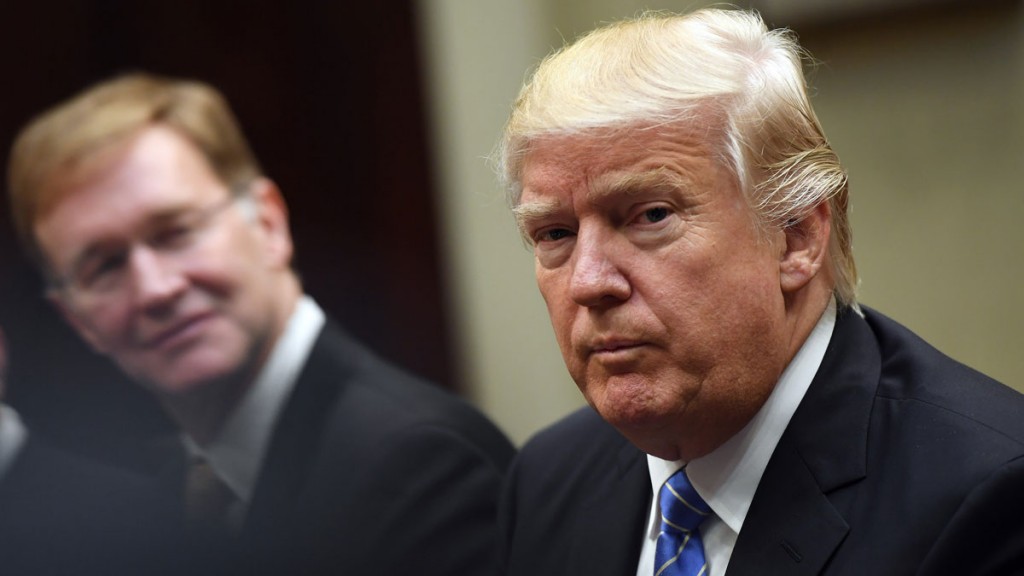
I’m getting déjà vu here.
We entered 2016 with everyone betting on a strong dollar. There seemed no sensible alternative. But because everyone was on one side of the bet, it had to be wrong. And by April, the dollar had weakened significantly.
It picked up later in the year. And when Donald Trump was elected, it went into overdrive.
As a result, we entered 2017 with everyone betting on a strong dollar. Again, there seemed no sensible alternative. Again, everyone was on one side of the bet.
You can see where I’m going with this, can’t you?
The Trump effect starts to wear off
The US dollar index (a measure of the dollar against a basket of its biggest trading partner currencies) dipped below 100 for the first time in 2017 yesterday.
The Trump bedazzlement has been wearing off somewhat. Markets had priced in all their hopes for the “good” bits about a Trump presidency – that he was Ronald Reagan returned, that he wasn’t serious about half the things he said before he was elected, that he wasn’t “big government” Hillary Clinton.
But now they are starting to wake up to the fact that he’s not all tax cuts and rampant infrastructure spending programmes. His inauguration speech was many things, but it wasn’t reassuring.
It didn’t focus on all the things that would make the stockmarket more cheerful, like added spending and lower taxes. It focused more on things that could scare financial markets, like protectionism and “Main Street” versus “Wall Street” and a rejection of the status quo.
It sounded like someone who was still in the process of campaigning rather than in the process of running the country. And maybe – just maybe – the markets started to think: “Hmm. Does this guy actually know what he’s doing or should we have been taking him at face value the whole time?”
Trump has started with a pretty powerful statement of intent. He has pulled out of the Trans-Pacific Partnership (TPP), an Asian free-trade deal. It wasn’t a surprise – Hillary Clinton was hardly enamoured of the deal either by the time the election rolled around, so it didn’t stand much chance of surviving. But it does show where Trump’s priorities lie.
Meanwhile, at a meeting with the chief executives of some of America’s biggest companies, he warned that he expects companies to produce their goods in the US. Companies that manufacture in the US will get tax breaks and fewer regulations. Those that build abroad then import their goods to the US will face a “substantial border tax”.
The ins and outs of these policies will be clearer as Trump’s presidency rumbles on. But the point for now is – this is all about “the people” rather than “the corporations” or the globalists.
Why did companies do outsourcing in the first place? Because it was cheap. It was good news for developed-world consumers (cheaper goods) and it was reasonably good news for workers in industrialising countries – they still had to work hard in conditions most of us wouldn’t be keen on, but it was better, and more lucrative, than the alternatives.
Trouble is, it wasn’t great for relatively low-skilled workers in developed countries. That’s arguably Trump’s key constituency. So you can see why he’s focusing on them.
Thing is, are those jobs going to “come back”? There have been some moves to “reshore” production in recent years in any case. China became far less appealing as a production hub amid rising wages and high transport costs.
However, if companies are effectively forced to reshore, I’d expect to see higher investment in robotics – replacing people with machines.
That’s not necessarily a bad thing. Automation has made many industries more efficient and more productive, while freeing up human beings to focus on new industries. But the transition process is painful.
Shares are not pricing in a squeeze on profit margins
However, fascinating as all of that is, it’s not really the main point for investors (though you should keep an eye on the robotics companies as a sector).
It all boils back down to this idea that Trump is focused on “main street” rather than “Wall Street”. There’s a chart going back decades now that compares the share of profits going to labour (workers) as opposed to capital (owners). Labour has been getting the rough end of the stick for a long time now.
Anyone who believes in reversion to the mean – as we do at MoneyWeek – has been wondering how this particular chart will revert. The political shift we’re seeing right now is just part of the answer.
A number of forces are working to drive up wages. Low unemployment, and an ageing workforce (meaning less competition). Higher wages mean less profit unless productivity rises, too – and so far it isn’t.
Then throw in the fact that energy costs have stopped falling; Trump’s anti-immigration policies; protectionism; and an aggressive political response to “cost-cutting” programmes.
All of that makes it pretty hard to keep profit margins on the rise. That might not matter, except that the US stockmarket is already very expensive relative to history. Companies as a whole are priced for continued earnings growth and continued high profit margins.
Over the longer run, deregulation and more investment in automation might help. But in the shorter run, markets are right to take a deep breath. If Trump succeeds in making life better for the man in the street, then the man in the boardroom might not be quite so happy.